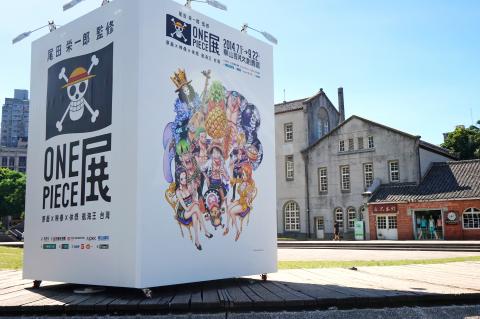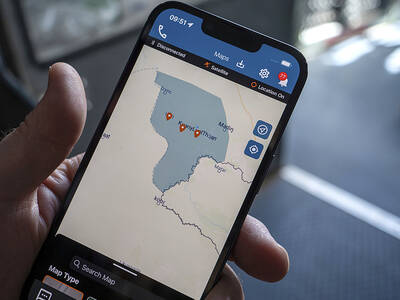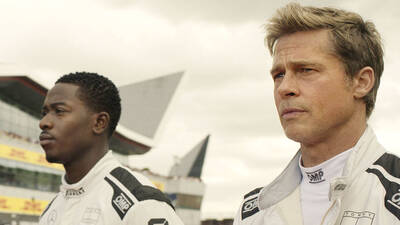For those of us who were teenagers in the 2000s, Japanese animanga was an inescapable fact of life, just as K-pop is today. Whether we loved it or ridiculed those who did, manga clubs, comic books and television series dominated our daily activities.
Since then, Taiwan has had its fair share of Japanese comic exhibitions and cosplay festivals. The latest incarnation of this ongoing trend is the One Piece (海賊王) exhibition at Huashan 1914 Creative Park (華山1914創意文化園區), which is titled after the well known Japanese comic of the same name. And despite being slightly overpriced at NT$320 per ticket, the exhibition, which is the first of its kind outside of Japan, succeeds at tapping into manga nostalgia.
NAVIGATING STORMY SEAS

Photo: Dana Ter
The displays are based on One Piece, a popular comic book and television series created in 1997 by Japanese cartoonist Eiichiro Oda.
The series — and exhibition — revolves around the adventures of a pirate king who assembles a crew of colorful characters with special powers as they search for One Piece, the most prized treasure of the stormy seas.
The rooms, designed as a life-sized maze, replicate the feeling of being inside a comic strip, where visitors each become a character in the story. Each room is designed to be another piece of the puzzle and visitors amass clues about the fate of each character as they move along in the exhibition.
The first room introduces the main characters — Luffy the Pirate King, Roronoa Zolo, Nami and Tony Tony Chopper. Their mugshots with the words “dead or alive” are plastered all over the walls. With floor-to-ceiling comic strips, three video presentations and interactive displays including a peek-a-boo window, the exhibition transports visitors to the Kingdom of Dressrosa, where the action takes place.
Even those unfamiliar with the story should have no problem picking up on its plotline — given that you can read and understand Mandarin as there are no English-language captions.
Visitors, mostly in their twenties and families with young children, were obviously die-hard fans. Some came in One Piece t-shirts, while the more adventurous wore costumes.
‘SELFIES’ PROHIBITED
From Hello Kitty to wild animal specimens, exhibitions around Taipei have been adapting to the “selfie” culture with displays serving the sole purpose of acting as backdrops for picture-taking. As one would be naturally inclined to think that an exhibition focused on manga would follow this trend, it came as quite a disappointment that photography is prohibited.
Looked at from another perspective, the no photography rule is refreshing because viewers can enjoy the art as it is, pre-mobile phone camera. Each display is meticulously labeled with the name of the episode and release date. And by concentrating on reading the comics and watching the short films, viewers are able to more fully immerse themselves into the story.
The illustrations are curated in a way that allows visitors to appreciate Oda’s craftsmanship. The last few rooms are devoted to showcasing his sketches and their subsequent transformation into comic strips and animations. A mockup of Oda’s work station is also on view, as well as his thought process in the form of rough sketches spiraling downwards from the ceiling to his desk.
With displays that highlight the depth and quality of the art itself, even those who mock manga might find something to muse over here, rather than writing it off as simply another comic exhibition riding the waves of a pop culture fad.

June 23 to June 29 After capturing the walled city of Hsinchu on June 22, 1895, the Japanese hoped to quickly push south and seize control of Taiwan’s entire west coast — but their advance was stalled for more than a month. Not only did local Hakka fighters continue to cause them headaches, resistance forces even attempted to retake the city three times. “We had planned to occupy Anping (Tainan) and Takao (Kaohsiung) as soon as possible, but ever since we took Hsinchu, nearby bandits proclaiming to be ‘righteous people’ (義民) have been destroying train tracks and electrical cables, and gathering in villages

Swooping low over the banks of a Nile River tributary, an aid flight run by retired American military officers released a stream of food-stuffed sacks over a town emptied by fighting in South Sudan, a country wracked by conflict. Last week’s air drop was the latest in a controversial development — private contracting firms led by former US intelligence officers and military veterans delivering aid to some of the world’s deadliest conflict zones, in operations organized with governments that are combatants in the conflicts. The moves are roiling the global aid community, which warns of a more militarized, politicized and profit-seeking trend

The wide-screen spectacle of Formula One gets a gleaming, rip-roaring workout in Joseph Kosinski’s F1, a fine-tuned machine of a movie that, in its most riveting racing scenes, approaches a kind of high-speed splendor. Kosinski, who last endeavored to put moviegoers in the seat of a fighter jet in Top Gun: Maverick, has moved to the open cockpits of Formula One with much the same affection, if not outright need, for speed. A lot of the same team is back. Jerry Bruckheimer produces. Ehren Kruger, a co-writer on Maverick, takes sole credit here. Hans Zimmer, a co-composer previously, supplies the thumping

Dr. Y. Tony Yang, Associate Dean of Health Policy and Population Science at George Washington University, argued last week in a piece for the Taipei Times about former president Ma Ying-jeou (馬英九) leading a student delegation to the People’s Republic of China (PRC) that, “The real question is not whether Ma’s visit helps or hurts Taiwan — it is why Taiwan lacks a sophisticated, multi-track approach to one of the most complex geopolitical relationships in the world” (“Ma’s Visit, DPP’s Blind Spot,” June 18, page 8). Yang contends that the Democratic Progressive Party (DPP) has a blind spot: “By treating any